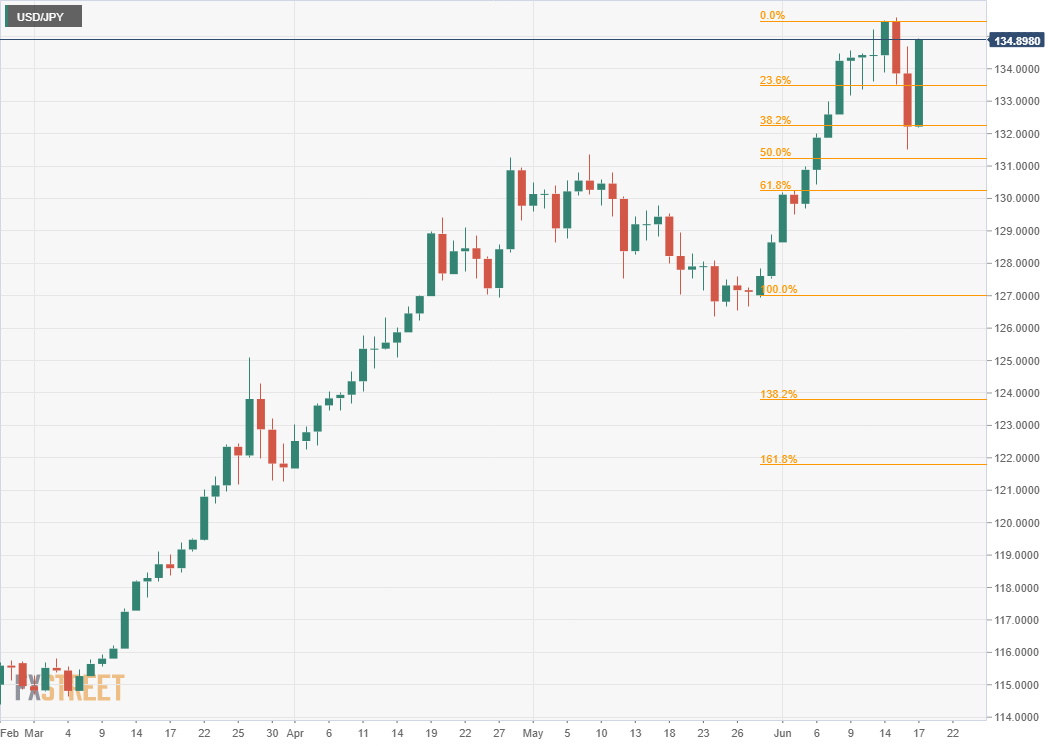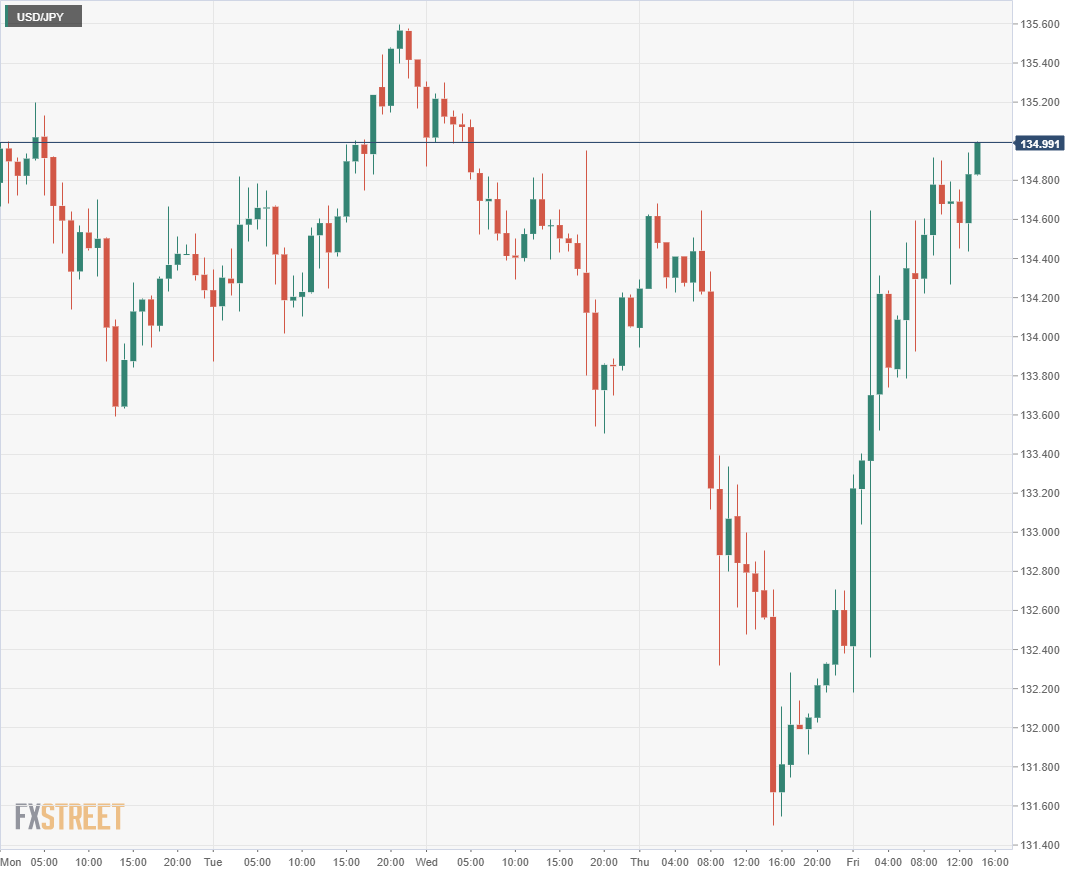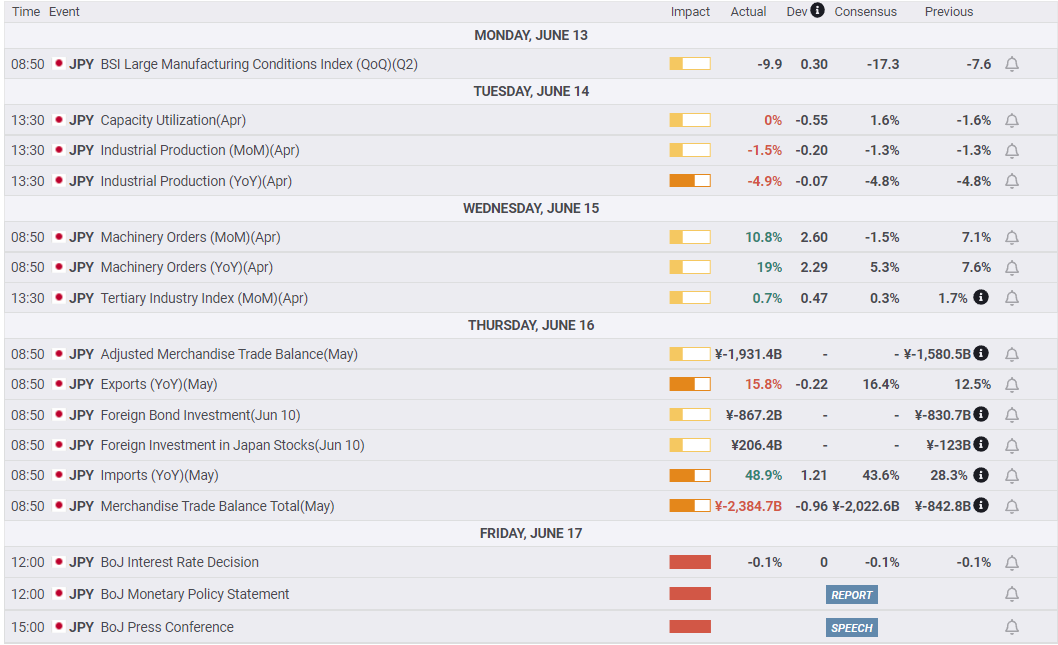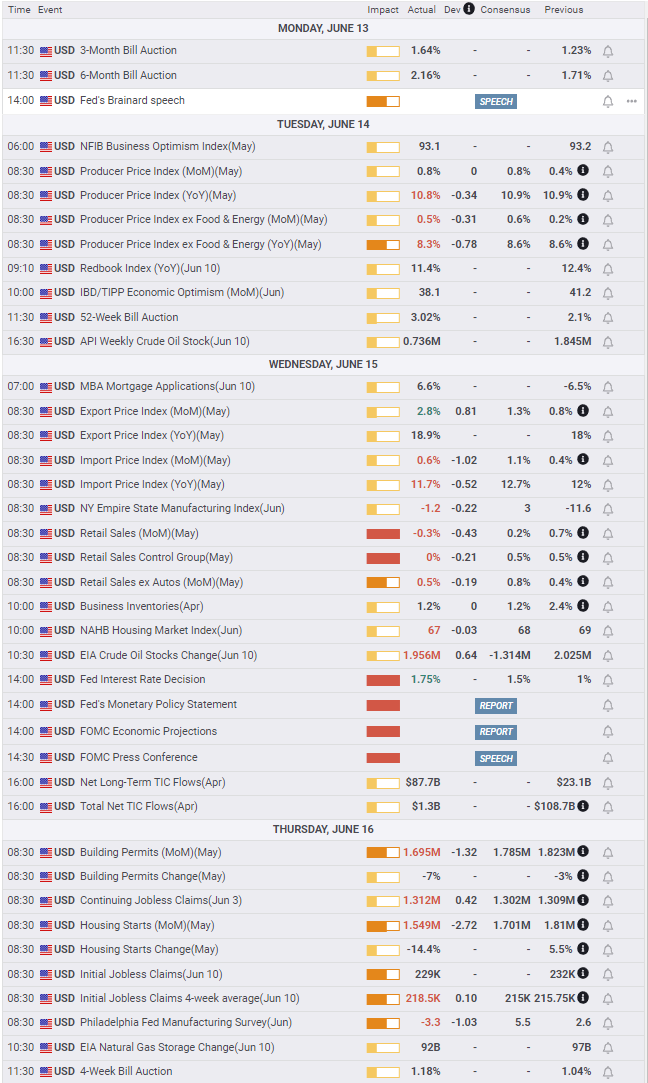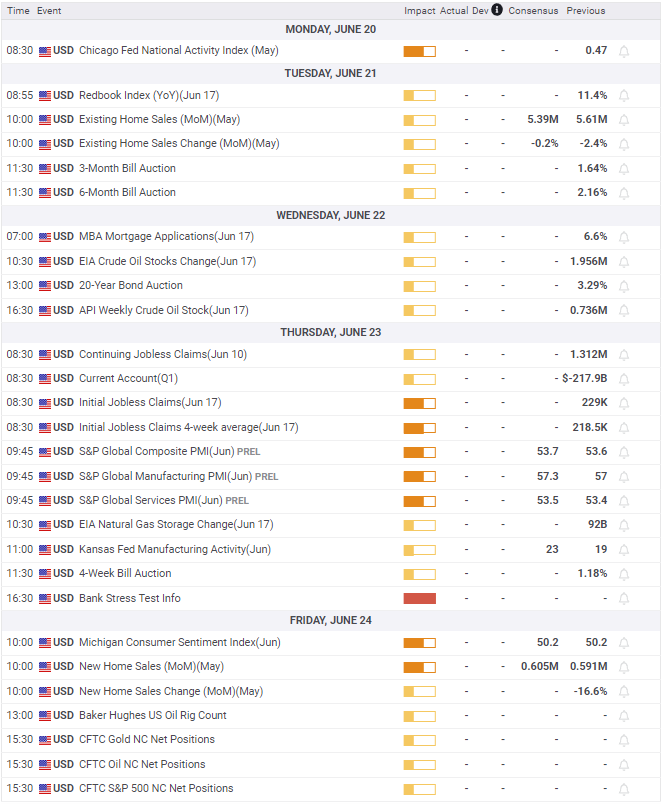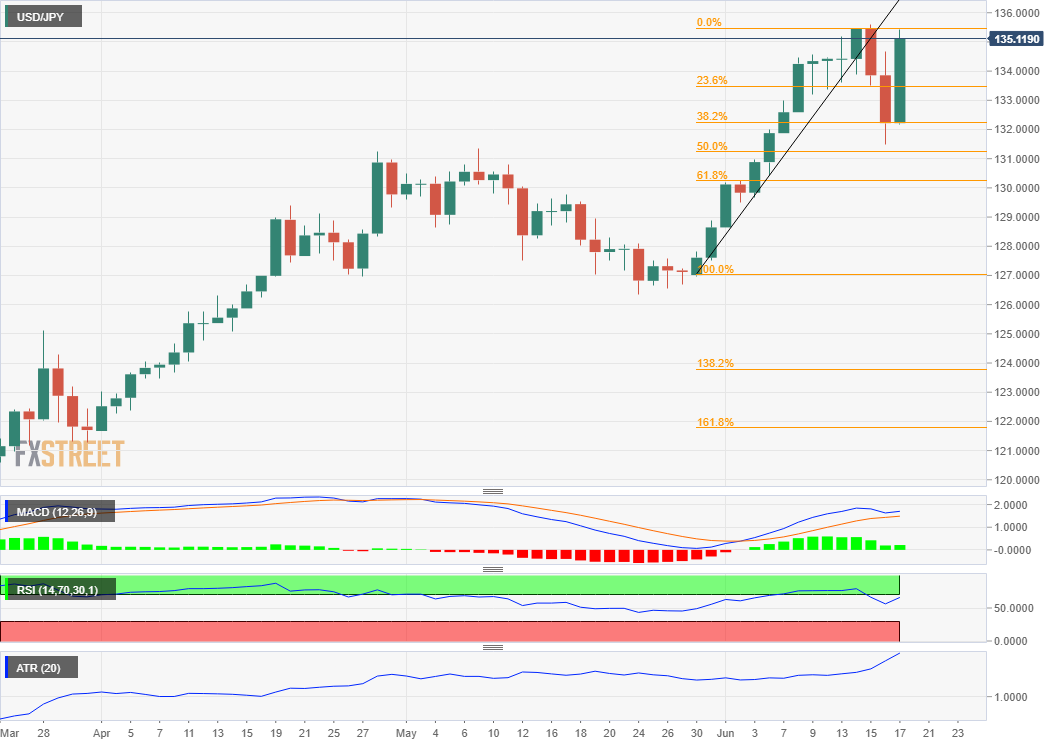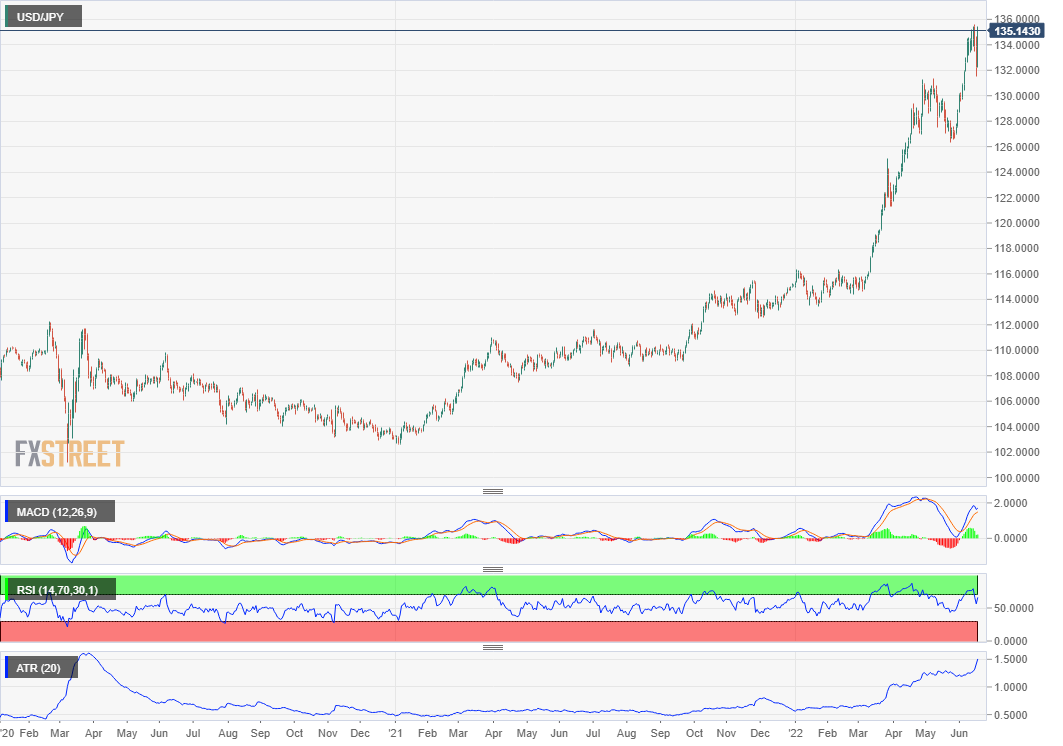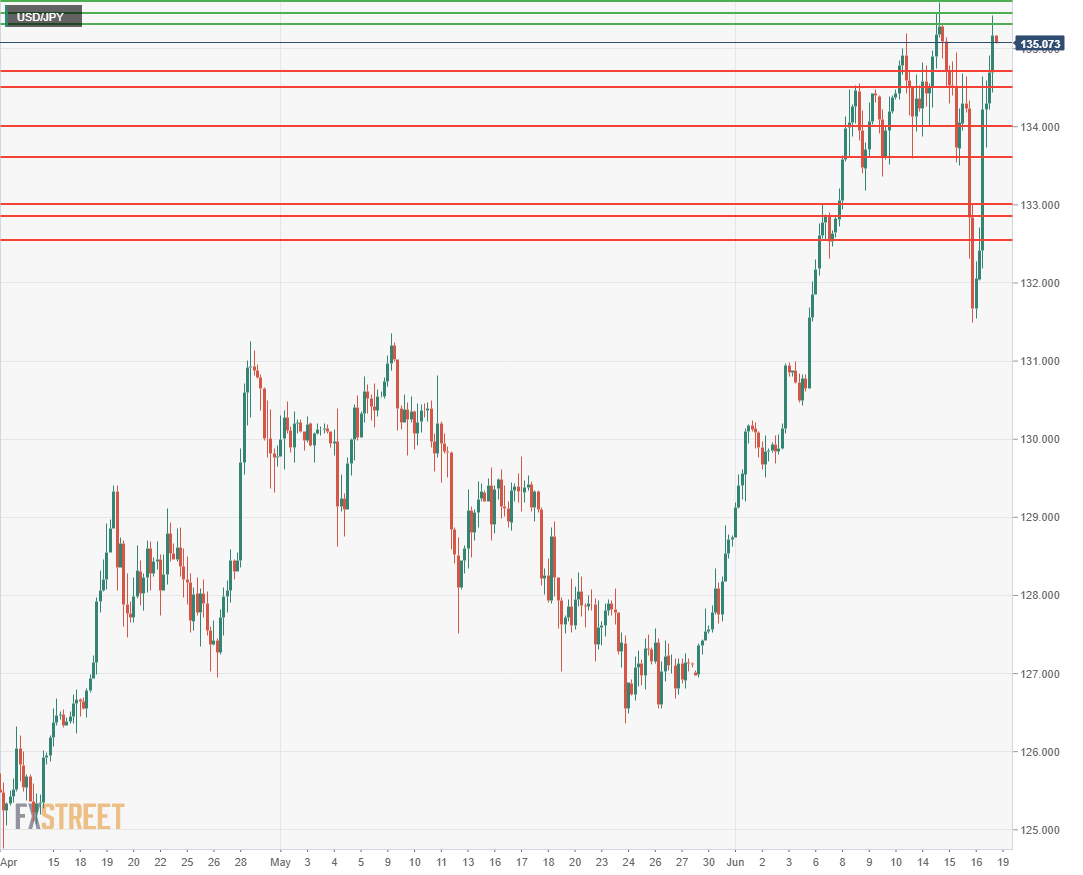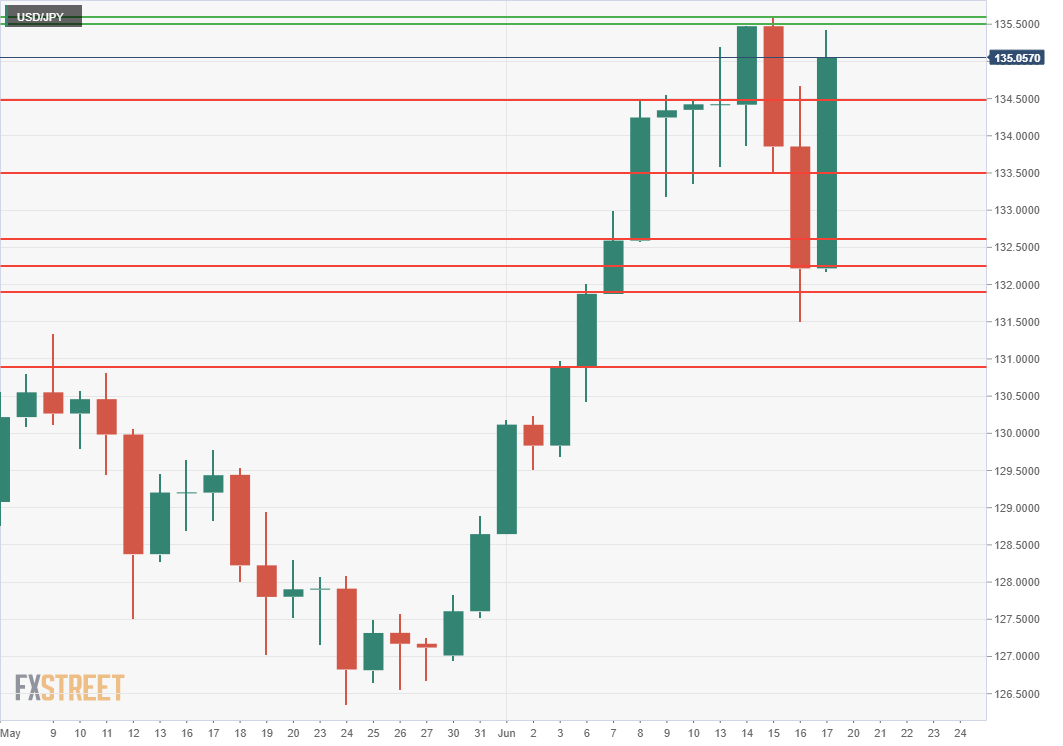- USD/JPY takes profit on Wednesday and Thursday, rebounds on Friday.
- BoJ leaves base rate and JGB yield control unchanged.
- USD/JPY rallies two figures after the BoJ decision.
- FXStreet Forecast Poll is uniformly bearish to one quarter.
There was never much chance that the Bank of Japan would modify its perennial easy money policy at its meeting on Friday. But when the possibility, however remote, was weighed against the 6.7% gain in the USD/JPY over the past three weeks and universal central bank tightening, the two-day profit run to below 132.00 on Wednesday and Thursday was eminently sensible. That it reversed at the 38.2% Fibonacci level of the May 30 to June 14 (127.01-135.47) move underlined its essential motivation.
The Bank of Japan (BOJ) left the base rate unchanged at -0.1% and did not alter its Yield Curve Control (YCC) policy defending yields in the Japanese Government Bond (JGB) market. The USD/JPY promptly reversed adding more than two figures from open to close on Friday in Tokyo.
Speculation that the BoJ might curb its monetary support had been based on the wave of central bank rate hikes–the Federal Reserve, the Bank of England and the Swiss National Bank, being the most recent–a reported comment in the Diet by BoJ Governor Haruhiko Kuroda that a shift in the bank’s monetary policy was possible, and by the evident hardship for Japanese consumers and importers caused by the yen’s excessive weakness.
The USD/JPY recovery came despite a drop in US Treasury rates this week as markets computed the odds of a US recession.
The Federal Reserve’s 75 basis point hike to a 1.75% upper target for the fed funds at Wednesday’s Federal Open Market committee (FOMC) meeting had been prompted by an unexpected 8.6% reading in May’s annual Consumer Price Index (CPI).
That acceleration above the March high of 8.5%, reported last Friday, led the Fed to the unusual step of changing its rate outlook during its two-week media blackout before the Federal Open Market Committee Meeting (FOMC).
At the previous FOMC on May 4, Chair Jerome Powell had said that a 0.5% hike was likely at the next meeting. May’s higher CPI was clearly a shock to the governors.
On Monday, the Wall Street Journal published an article, assumed to be sourced from the Fed, that the rate prescription for the Wednesday meeting was now 0.75%. Markets took the information as gospel.
Mr. Powell dropped a number of broad hints in his press conference that more 75 basis point increases are possible, though the Treasury markets paid more attention to the rising possibilities of a recession.
The Fed also issued its updated economic and rate projections, the second of four each year.
The year-end estimate for the fed funds rate rose to 3.4% from 1.9% in March, implying a doubling from its current level. Economic growth in 2022 dropped to 1.7% from 2.8%, PCE inflation rose to 5.2% from 4.3% and core to 4.3% from 4.1%. Inflation is still expected to decline in 2023 to 2.6% for headline and 2.7% for core, barely changed from the March projections.
There were no changes to the balance sheet reduction program that began this month with a $47.5 billion roll-off of maturing securities.
The US dollar fell after the Fed meeting, partly in a normal reaction to a highly anticipated event, partly from some judicious profit-taking on the long ascent and partly from lower Treasury yields.
Economic growth prospects in the US slipped as the Atlanta Fed GDPNow model, one of the most widely followed indicators, lowered its second quarter estimate to 0.0% from 0.9% after Retail Sales and other statistics were weaker than forecast.
Japanese economic data was limited and of no market impact. Industrial Production was slightly weaker in April than forecast as were annual exports in May, though imports were stronger.
American Retail Sales were unexpectedly negative in May, Housing Starts fell by the most since April 2020 at the height of the pandemic lockdowns and the Producer Price Index was over 10% annually for the fifth month in a row.
Inflation is no longer just a consumer annoyance in the US but is beginning to affect economic activity. Industrial Production in May at 0.2% was lower than the 0.4% prediction, though April was revised to 1.4% from 1.1%.
USD/JPY outlook
The conclusion of the Fed and BoJ meetings returned the USD/JPY to a firm dollar advantage. Of more importance will be the restraint of the Treasury market on Fed intentions. At the moment the retreat of yields has been minimal in comparison to the huge recent gains. But the Treasury market will go its own way, regardless of stated Fed policy. It is entirely conceivable that if US economic data points south, rates will continue to come off. That is the primary risk for the USD/JPY which otherwise has few reasons to retreat.
Japan’s National CPI numbers for May should confirm the impact of global inflation, but with the BoJ decision past, they will have no market effect.
In the US, Existing Home Sales could fall more than the 0.2% forecast in May, confirming the impact of rising mortgage rates and adding one more item to the recession list. The revision to June’s Michigan Consumer Sentiment number does not normally attract attention, but given its record low, it will be watched for a further decline.
The outlook for the USD/JPY is higher with the caveat that declining US Treasury rates could again excite profit-taking on the large gains since early March.
Japan statistics June 13–June 17
US statistics June 13–June 17
Japan statistics June 20–June 24
FXStreet
US statistics June 20–June 24
FXStreet
USD/JPY technical outlook
Technical indicators are mildly supportive of a higher USD/JPY. The MACD (Moving Average Convergence Divergence) and the Relative Strength Index (RSI) rebounded with Friday’s two-figure surge. The MACD price line came close to crossing the signal line on Thursday and the reopened spread is not a strong signal. The USD/JPY failed to establish a new high on Friday trading to 135.42 just under Wednesday’s top at 135.60. The angle of the ascent from May 30 was unsustainable so the fall below the trendline is not indication that that upward momentum is broken.
Volatility in the Average True Range (ATR) is as high as it has been since the lockdowns of March 2020.
Support and resistance above 131.00 is best ascertained on the four-hour chart reinforced by the dailies. Support is far more plentiful and frequent beneath with the main range definition at 133.60.
Four-hour chart
Resistance: 135.30, 135.45, 135.60
Support: 134.50, 134.00, 133.60, 133.00, 132.85, 132.55
Daily chart
Resistance: 135.50, 135.60
Support: 133.50, 132.60, 132.25, 131.88, 130.88
FXStreet Forecast Poll
The FXStreet Forecast Poll looks to progressive profit-taking declines in the USD/JPY breaching support at 133.60 in the coming week.
Information on these pages contains forward-looking statements that involve risks and uncertainties. Markets and instruments profiled on this page are for informational purposes only and should not in any way come across as a recommendation to buy or sell in these assets. You should do your own thorough research before making any investment decisions. FXStreet does not in any way guarantee that this information is free from mistakes, errors, or material misstatements. It also does not guarantee that this information is of a timely nature. Investing in Open Markets involves a great deal of risk, including the loss of all or a portion of your investment, as well as emotional distress. All risks, losses and costs associated with investing, including total loss of principal, are your responsibility. The views and opinions expressed in this article are those of the authors and do not necessarily reflect the official policy or position of FXStreet nor its advertisers. The author will not be held responsible for information that is found at the end of links posted on this page.
If not otherwise explicitly mentioned in the body of the article, at the time of writing, the author has no position in any stock mentioned in this article and no business relationship with any company mentioned. The author has not received compensation for writing this article, other than from FXStreet.
FXStreet and the author do not provide personalized recommendations. The author makes no representations as to the accuracy, completeness, or suitability of this information. FXStreet and the author will not be liable for any errors, omissions or any losses, injuries or damages arising from this information and its display or use. Errors and omissions excepted.
The author and FXStreet are not registered investment advisors and nothing in this article is intended to be investment advice.
Recommended Content
Editors’ Picks
AUD/USD could extend the recovery to 0.6500 and above

The enhanced risk appetite and the weakening of the Greenback enabled AUD/USD to build on the promising start to the week and trade closer to the key barrier at 0.6500 the figure ahead of key inflation figures in Australia.
EUR/USD now refocuses on the 200-day SMA

EUR/USD extended its positive momentum and rose above the 1.0700 yardstick, driven by the intense PMI-led retracement in the US Dollar as well as a prevailing risk-friendly environment in the FX universe.
Gold struggles around $2,325 despite broad US Dollar’s weakness

Gold reversed its direction and rose to the $2,320 area, erasing a large portion of its daily losses in the process. The benchmark 10-year US Treasury bond yield stays in the red below 4.6% following the weak US PMI data and supports XAU/USD.
Bitcoin price makes run for previous cycle highs as Morgan Stanley pushes BTC ETF exposure

Bitcoin (BTC) price strength continues to grow, three days after the fourth halving. Optimism continues to abound in the market as Bitcoiners envision a reclamation of previous cycle highs.
US versus the Eurozone: Inflation divergence causes monetary desynchronization

Historically there is a very close correlation between changes in US Treasury yields and German Bund yields. This is relevant at the current juncture, considering that the recent hawkish twist in the tone of the Federal Reserve might continue to push US long-term interest rates higher and put upward pressure on bond yields in the Eurozone.
